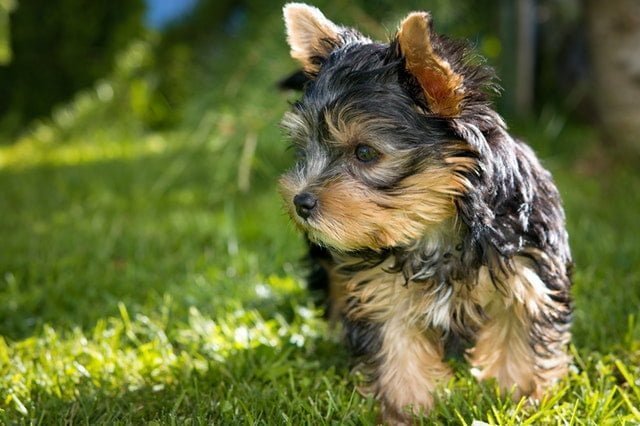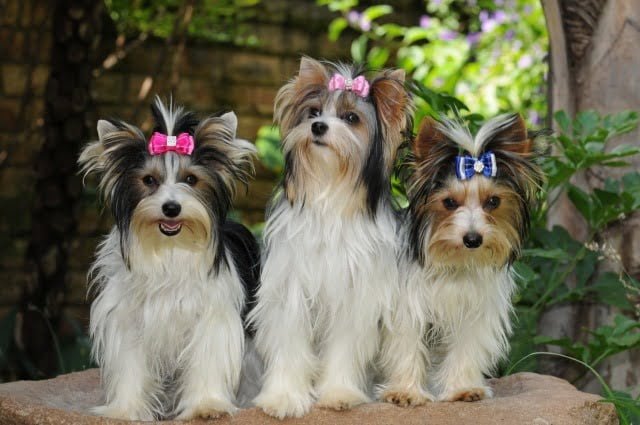The Yorkshire Terrier in particular, nicknamed the “Yorkie”, is one of the most popular of dog breeds. It was bred specifically for companionship. We love the Yorkie for its big personality for its size, its grace, its long, flowy hair and its devotion to its owner. It’s so devoted that every time you leave home, whether for work or errands, they actually suffer separation anxiety.
The Yorkie breed itself is further divided into other types based on their fur, and one of the most recent to be recognized is the Parti Yorkie. The Parti Yorkie has enjoyed a rise in popularity over the years. However, they had a rocky past. Parti Yorkies have been a divisive breed, and even today, there is resistance amongst breeders of accepting their existence.

In their most basic elements, however, Parti Yorkies are just Yorkies that have a different coloration than normal. But what makes the colorations between a Parti Yorkie vs Yorkie that’s normal so different? Well, we’ll look into these differences closely. First we will go through the history of how Yorkies came to be. We will also look at why the color of their fur is so important..
The History of the Regular Yorkshire Terrier

The origins of the Yorkshire Terrier isn’t exactly clear. Their naming suggests that they originated, or at least were first recognized, as their own breed in Yorkshire, England. Yorkies basically started out as an amalgamation of various different breeds brought together completely by accident. What is known is that the breed itself as we know it is almost 200 years old. During the 1800’s, Scottish workers moving into Yorkshire for work brought a variety of terriers with them as companions.
The Yorkshire Terrier’s ancestors were originally bred by these Scottish migrants, as well as local mill owners and farm hands. The owners used these terriers to catch rats on the land they worked on. The resulting dogs were also proficient at chasing badgers and foxes into their burrows and flushing them out. So they saw a lot of work in the fields. These terrier breeds, however, were a very different from the Yorkie we know today. They were mostly a mishmash of numerous other existing Terrier breeds.

During this time, there was no conscious effort to actually create a breed that would eventually resemble a Yorkie. Most of the people who used Yorkies for work didn’t really put much thought as to which dog bred with which, so long as they did their jobs well enough. Eventually, however, many breeders noticed a good number of traits on these farm Terriers. They eventually made the conscious effort to produce a show breed with a distinctly long, silky hair. These professional breeders have found a good template to work on. During the first decades of the 1800’s, the ancestors of the Yorkie soon surfaced.
Yorkies could trace their lineage to the Waterside Terrier, a Scottish breed known for its long, beautiful, blue-gray coat. Some historians also believe that breeders used the Paisley Terriers, a smaller variant of Skye Terriers, and the Maltese to produce this breed.
Early prototypes of the breed existed as early as the 1830’s. In the the 1860’s they were officially recognized as their own breed. A very famous Yorkshire Terrier named Huddersfield Ben, owned by a woman named Mary Ann Foster, became the poster child for the Yorkshire Terrier. This particular Yorkie became famous for captivating its viewers in the many dog shows he attended.
Mary Ann Foster’s Yorkie soon became the template for how the breed is supposed to look for years to come. Huddersfield Ben was described by breeders as the best stud dog of his time. He fathered many litters, and was later named as the father of the Yorkshire breed.
The Yorkie that we know of today is actually smaller than the Yorkies that first showed up in the 1800’s. Yorkies were originally bred to control pests. But Yorkies nowadays are more of a toy breed rather than actual rat hunters.
The Yorkshire Terrier was introduced to North America in 1872. In 1885 the first one was registered to the American Kennel Club. The Yorkie was a popular pet during the Victorian era, but their popularity started to wane by the 1940’s. By the end of the Second World War, however, a famous war dog named Smoky reignited the breed’s popularity. Today the Yorkie is the 6th most popular breed in the United States.
The Parti Yorkie Background
Although they have enjoyed plenty of recognition nowadays, the Parti Yorkie has had a very rough start. This variant of the Yorkshire Terrier has showed up as early as the breed itself. Even during the 1800s, when the Yorkie breed itself was still being tweaked. Yorkies with blue and gold colorations were considered the most favorable look back in the early days of the breed. Certain tri-colored yorkies, as the Parti Yorkie, was seen as undesirable.

These parti-colored Yorkies were at first considered to be low-quality animals. Many breeders didn’t want their names or their animals sullied by these uniquely colored dogs. As a result, the puppies were either put down or given away in secret. At one point in history, these Yorkie variants were in danger of disappearing entirely. But a surge in popularity many years later helped this breed survive.
The practice of putting down Parti Yorkie pups was still prevalent even in the late 1900’s. Things changed in the 1980s, however, when one breeder refused to put down their pups because of their different colors. Soon enough, the practice of putting down Parti pups fell out of favor among Yorkie breeders. By 2000, the American Kennel Club formally accepted the Parti coloration was as a legitimate Yorkshire Terrier variant.
Despite this, however, many purist breeders today still view the Parti Yorkie as an impure Yorkie lineage. Some still believe that pure Yorkshire Terriers shouldn’t have any white fur on them at all. Still, this hasn’t hindered any of the Parti Yorkie’s rise to popularity amongst many dog breeders.
Are Parti Yorkies Purebred?
There is a common misconception that this variation of Yorkie isn’t actually purebred. People mistakenly believe that its unique coloration is the result of interbreeding with other dog breeds. Some people mistake Parti Yorkies as long-coated mutts with Yorkie bloodlines. During the Yorkie’s early days, some breeders even believed that these slight variations on the coats were leftover genes from their Maltese or Waterside Terrier bloodlines.
The truth, however, is that Parti Yorkies can show up in a purebred litter. Even Yorkies not known to have ancestors that produce Parti Yorkies can produce puppies with the unique Parti coloration. So yes, Parti Yorkies are indeed purebred Yorkshire Terriers.
The Parti Gene
So, how do purebred Yorkies produce puppies that are not of the same coloration as they are? Well, it all comes down to basic genetics, and what breeders call the Parti Gene. The Parti Gene is responsible for producing puppies with the Parti tricolor. The gene itself is a recessive gene, much like how having blue eyes in humans is also recessive.
This means that having one parent that is the Parti carrier Yorkie is not enough to produce a Parti Yorkie. You will need two dogs who carry the gene in order to have a chance of having a litter with a Parti Yorkie in it. Even with two gene carriers, it’s not always a guarantee that you’ll get a Parti Yorkie.

The gene itself can still be passed on to an offspring and lay dormant. So even though they don’t have the distinct coloration themselves, they can produce Parti offspring. If you trace the dogs’ ancestry and can’t find a Parti Yorkie in the family tree; they may still bear litters that have Parti Yorkies in them.
In one litter where both parents are Parti carrier Yorkie, at least 50% of the puppies will have the standard blue and tan coloration but will be carriers of the gene themselves. 25% of the litter will also be regular Yorkie, but will not be carriers of the Parti Gene. The other 25% will have the Parti colors. Sometimes, even if they are Parti Yorkies, they may go unnoticed. The third color can sometimes become muted, and only the traditional blue and tan colors may look the most prominent.
It is also very difficult to differentiate the Parti carrier yorkie from the ones that don’t actually carry the gene. There are practically no visual indicators available. This makes keeping track of the actual gene carriers nearly impossible.
This makes Parti Yorkies pretty much an uncommon sight, or very difficult to produce on purpose. If you want to consistently produce Parti Yorkies, you will need to breed one Parti Yorkie with another Parti Yorkie. But then again, they can still produce Regular Yorkies, though at a much lower rate.
What are the Different Colors Parti Yorkies Come In?
We’ve looked in-depth at how Yorkies and their Parti counterparts came to be. Now let’s look into the differences between the Parti yorkie vs yorkie classic. Traditional Yorkshire Terriers come in a variety of two different colors. They can either be black and tan, black and bluish-silver or blue and tan. Parti Yorkies will come with either of these combinations, but will also come with an additional third color. This third color is usually chocolate/tan or white.

The most common Parti coloration is tan, white and black. The intensity of each coloration varies greatly from one individual to another. It’s possible to have an actual Parti Yorkie, but have its third color practically hidden, muted or negligible, making it look like a traditional Yorkie. It’s also possible to find Parti Yorkies that are in one solid color, such as a pure chocolate Yorkie or a purely Blonde one. Solid colored Yorkies are very rare, however.
Here is video with adorable parti-yorkie puppies in various colors:
Parti Yorkies and Biewer Terriers
Because they have very similar colorations to Parti Yorkies, and because they’re also known as German Yorkies, Biewer Terriers, or German Terriers, often get confused with Parti Yorkies. Despite them more or less sharing the same family lineage, the Biewer is actually considered a distinct breed. Because of the recessive nature of the Parti Gene, it actually becomes difficult to reproduce dogs that consistently have this unique coloration.
In the 1970’s however, the German couple Mr. and Mrs. Biewer, from which the breed got its name, stepped up to the challenge. The couple began making the effort of producing Yorkshire Terriers with the unique tan, white and black coloration. It took a lot of patience and perseverance on their part to consistently produce pups with this coloration, but they eventually did it, and the AKC has since accepted the Biewer Terrier as its own distinct breed from the Yorkshire Terrier.
Here is a video of extremely cute Biewer Puppies:
Although Biewer Terriers were bred from Parti Yorkies, and that they share the same color combinations, such as either black, white and tan, or blue, white and tan, there are distinct differences between the German Terrier and their Yorkie cousins. One of the easiest ways to spot the difference between the Parti Yorkie and the Biewer Terrier is the tail. Biewer Terrier breeds maintain a full-length tail, as opposed to the Yorkie’s docked tails. This is because tail-docking is illegal in mainland Europe, so the practice, which is a breed standard for Yorkshire Terriers elsewhere, is very rarely done in Germany.
References
http://drjtest.com/yorkshire/history.htm
http://www.yorkshireterrierclub.com/biewersvspartiyorkies.html
https://yorkiesbykelly.com/what_is_a_parti_yorkie.html

